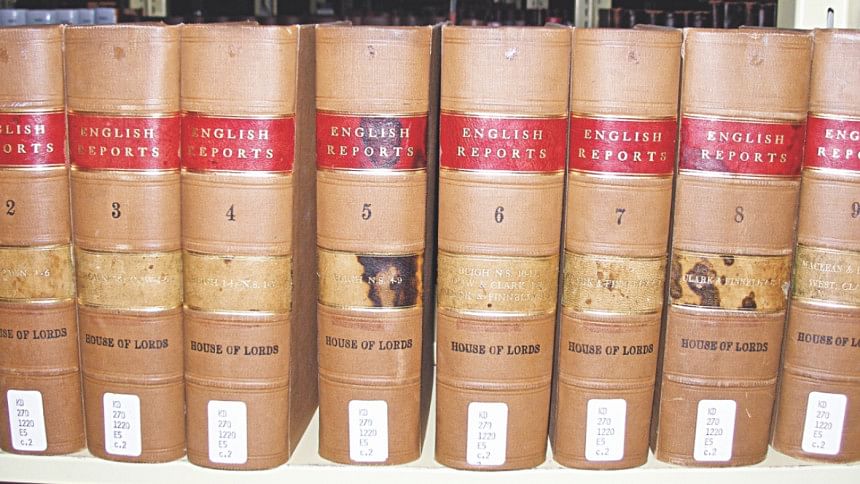Guide to find and read law reports

Reading through topical case laws is a must for all law students. This is not only confined within knowing about celebrated age-old judicial decisions, but also extends to get oneself be acquainted with newly held decisions of both home and abroad.
There are many places and techniques to search for judicial decisions. Law reports are the reliable and available source of finding mostly important court decisions. In the context of Bangladesh, there are many institutions that publish decisions of the Supreme Court of Bangladesh. Dhaka Law Reports (DLR), Bangladesh Legal Decisions (BLD), Mainstream Law Reports (MLR), Bangladesh Law Chronicles (BLC), Bangladesh Law Times (BLT), Law Guardian (LG) and many others publish Supreme Court decisions both monthly and yearly in order to provide for ready case references to the members of legal community and people at large. Under the guidance from the Judicial Reform Committee, the Supreme Court of Bangladesh has also started publishing an online law report named Supreme Court Online Bulletin (SCOB) which compiles important judgments from the Appellate Division and the High Court Division. Till December 2015, it has published five issues which are available at Supreme Court website.
After the Supreme Court of Bangladesh was established in 1972, it initially published a law report, containing the judgments, orders and decision of the Court. To note, there is no such institutions that publish decisions held by the sub-ordinate courts in Bangladesh. Few law reports, however, publish the decisions of special courts/tribunals such as the decisions of Administrative Tribunal, International Crimes Tribunal, Bangladesh Bar Council Tribunal, etc. either in regular or special issue.
Generally, law report is a record of a judicial decision on a point of law which sets a precedent. The binding effect of Supreme Court judgments as 'precedents' has been well clarified in article 111 of the Constitution of Bangladesh which says that the law declared by the Appellate Division is binding on the High Court Division and the law declared by either division of the Supreme Court is binding on all courts subordinate to it. A plain reading of this constitutional provision gives rises to a misconception among the common people that judge's decision delivered in the court of law always creates a binding precedent. Yes, it does; but a decision which does not lay down any legal principle ought not to be considered as a binding precedent [see, M. P. v. Bablu Natt (2009) 2 SCC 272 and Sufia Khatun v. Mahbuba Rahman (2010) 30 BLD (AD) 41]. In other words, not all decisions taken in a court of law or published in a law report qualifies to be a precedent.
Of any law report available in print form, at the very beginning the reader will find the updated list of judges of the Supreme Court of Bangladesh, and that of law officers who represent the government in the Supreme Court. Law reports also include a complete list of statutes that get passed in concerned year by the National Parliament. For the readers easily to find decisions, each law report has separate section containing the decisions of both the Divisions of the Supreme Court.
In the table of contents, anyone can find the list of decisions held in civil disputes, criminal cases, special original litigations (PIL, constitutional issues, etc.), and statutory original matters (income tax/VAT and company matters, etc.). Titles of the cases suggest names of the parties involved in the litigation.
Index of cases contains the highlighted portions of the decisions (a brief summary of the case, the holding, and any significant case law considered) selected by the editors of each law reports which are known as head-notes. It is important to mention that these highlighted notes are not to be taken as the ratio decidendi or obiter dicta of the decisions. One needs to read the full judgment and get the ration decidendi as well as obiter dicta after applying proper knowledge of law and jurisprudence [see for details, Mahmudul Islam, Constitutional Law of Bangladesh (Dhaka: Mullick Brothers), 2012, pp. 910-18].
Referring to relevant laws or rules, these head-notes generally guide the readers to find detailed discussion in full judgment. Index is presented with a specific reference to Constitution, Statutory Act, Rule, Regulation or Order. Hence, it is easy to find cases related to any specific law or constitutional provision by seeing only the alphabetical order of laws in the index.
It is to be remembered that law reports are edited publications and do not contain all the decisions of each year. Therefore, law reports vary from one to another in publishing judicial decisions.
The importance of law reports lies in section 3 of the Law Reports Act, 1875 which says that courts in Bangladesh are not 'bound to hear cited, or […] receive or treat as an authority binding on it, the report of any case decided by the Supreme Court, other than a report published under the authority of Government.' This implies that reported case laws have considerable amount of impact on the functioning of judiciary. Application of law reports is also essential to understand the judge's depth of knowledge in writing judgments. In present scenario, we often see that lower courts – and even different benches of the High Court Division – deliver inconsistent and/or contradictory pronouncements on a particular legal issue. The consequence of which is evident in SCOB editorial note of Justice Moyeenul Islam Chowdhury and Justice Sheikh Hassan Arif that 'these inconsistencies, though rare, draw criticisms and harsh strictures from the Appellate Division'. For determining the real position of law, therefore, it is imperative to know the day-to-day legal developments with the help of law reports so that individuals concerned with law's application in practical life can knowledgably contribute to the society.
THE WRITER IS AN ADJUNCT FACULTY MEMBER AT NORTHERN UNIVERSITY BANGLADESH.

 For all latest news, follow The Daily Star's Google News channel.
For all latest news, follow The Daily Star's Google News channel. 



Comments